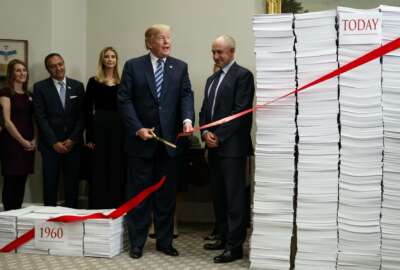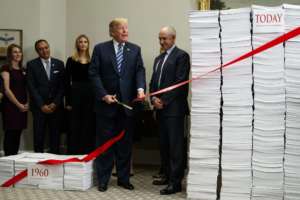
Administration claims billions in regulatory savings in 2017, promises more in 2018
Federal agencies exceeded expectations of President Donald Trump’s administration in 2017, eliminating 22 regulatory actions for every one that was introduced...
Federal agencies exceeded the deregulation goals of President Donald Trump’s administration in 2017, eliminating 22 regulatory actions for every one that was introduced and canceling or delaying more than 1,500 planned regulatory actions. That saved $8.1 billion in lifetime net regulatory cost savings, or $570 million per year, according to the administration.
Through the end of September, agencies killed a total of 67 regulatory actions, and only introduced three. The 1,579 refers to planned actions that were withdrawn, canceled or delayed by the agencies.
“We have decades of excess regulation to remove to help launch the next phase of growth, prosperity and freedom,” Trump said during a Dec. 14 White House event. “I am challenging my Cabinet to find and remove every single outdated, unlawful and excessive regulation currently on the books. I want every Cabinet secretary, agency head and federal worker to push even harder to cut even more regulations in 2018.”

Standing beside stacks of paper meant to illustrate the difference, Trump said that since 1960, the Code of Federal Regulations has grown from roughly 20,000 pages to more than 185,000. But he promised that the code would soon be reduced to the 1960 levels, and possibly even further.
“We know that some of the rules contained in these pages have been beneficial to our nation, and we’re going to keep them,” Trump said. “We want to protect our workers, our safety, our health. We want to protect our water. We want to protect our air and our country’s natural beauty. But every unnecessary page in these stacks represents hidden tax and harmful burdens to American workers and to American businesses, and, in many cases, means projects never get off the ground. That’s probably the biggest problem.”
However, Neomi Rao, administrator of the Office of Information and Regulatory Affairs at the Office of Management and Budget, walked that promise back later in the day, telling reporters during a press briefing that such an extreme reduction would likely require legislation due to the number of regulations with statutory requirements.
But the White House’s Regulatory Plan and Unified Agenda of Regulatory and Deregulatory Actions directs agencies to continue efforts at deregulation. It sets the goal for fiscal 2018 at three deregulatory actions for every new regulation, which should result in savings of $9.8 billion in lifetime regulatory costs, or around $686.6 million per year.
Rao told reporters most of these deregulatory actions are carried out at the agency level by a mix of career officials and political appointees. And those deregulatory actions can include guidances and information collections as well, not just the regulations themselves.
The Environmental Protection Agency instituted 16 deregulatory actions in 2017, the most out of any other agency or department. The Department of Interior was next at 12 deregulatory actions. EPA and the Energy and Health and Human Services departments each instituted one new regulatory action.
Copyright © 2024 Federal News Network. All rights reserved. This website is not intended for users located within the European Economic Area.
Daisy Thornton is Federal News Network’s digital managing editor. In addition to her editing responsibilities, she covers federal management, workforce and technology issues. She is also the commentary editor; email her your letters to the editor and pitches for contributed bylines.
Follow @dthorntonWFED





